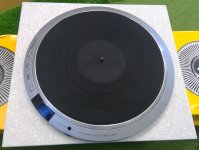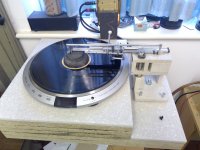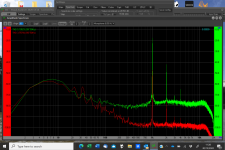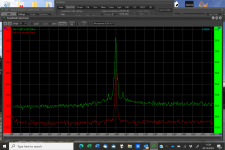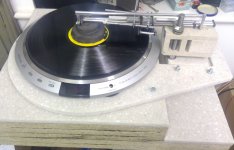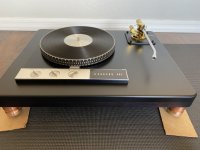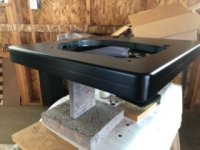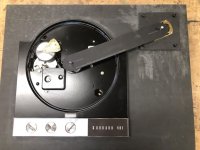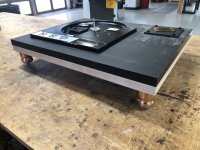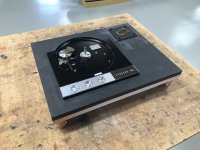The thread has paused and meanwhile i will shortly try a direct drive turntable (victor 81) and wish to build a simple cost effective plinth.Contact adhesive.
I see multilayer chipboard (floorboards) preferred to MDF. Any additional thoughts please?
M
The TT-81 is a great turntable. Just restored one for a friend.
Think about the function of the plinth. Is it supporting the TT, or the tonearm, or both? The TT-81 doesn't need a plinth, you can run it freestanding if you have a separate tonearm pod. And often, separating functions make life easier
As Henry Royce said, "at the limit, everything is rubber". There are so many variables that you might be better off just building something and trying it. Then figure out what problems remain. Good luck!
Think about the function of the plinth. Is it supporting the TT, or the tonearm, or both? The TT-81 doesn't need a plinth, you can run it freestanding if you have a separate tonearm pod. And often, separating functions make life easier
As Henry Royce said, "at the limit, everything is rubber". There are so many variables that you might be better off just building something and trying it. Then figure out what problems remain. Good luck!
Thanks Mikey, I aim to achieve the best coupling I can between the stylus through the tonearm to the plinth to the motor unit and to the platter/spindle. So, the plinth is supporting motor unit and TA. To do this i will rigidly mount the TT and TA to the same base. I aim to make that base (plinth) able to dissipate vibration as well because of the materials and mass. My logic says this entails a large mass of non resonant material such as chipboard. The main plinth will be isolated from the wall shelf in some way to avoid vibration coming the other way. My RTA needs to stay absolutely level, so flexible mounts are out.The TT-81 is a great turntable. Just restored one for a friend.
Think about the function of the plinth. Is it supporting the TT, or the tonearm, or both? The TT-81 doesn't need a plinth, you can run it freestanding if you have a separate tonearm pod. And often, separating functions make life easier
As Henry Royce said, "at the limit, everything is rubber". There are so many variables that you might be better off just building something and trying it. Then figure out what problems remain. Good luck!
I shall indeed probably build and see, as you suggest!
M
Hi Mike,The thread has paused and meanwhile i will shortly try a direct drive turntable (victor 81) and wish to build a simple cost effective plinth.
I see multilayer chipboard (floorboards) preferred to MDF. Any additional thoughts please?
M
Sorry for the slow reply, Busy here for the past 6 months.
From other materials (I have not tried not chipboard so far), I do like multiple layers. I would guess that if your Chipboard is thin enough, you could use 4 or 6 layers. Greenglue or Ductseal compressed between the layers is what I've found to be more effective than a solid piece.
Neither Greenglue or Ductseal is an adhesive, so some low pressure from Nylon bolts or similar in the corners and a few other spots is needed to keep the layers together. Greenglue seems to stay gooey and pliable. GB Ductseal does dry out after many years.
Another material that's easy to get here is Hardboard. Simlilar to mdf, but it's available in 1/8"and 1/4". The overall thickness can be kept to a minimum.
Hugh
Hi Hugh and thanks for your reply, you must also be telepathic, i was gluing up the plinth when your reply was posted. So, what have i learnt?Hi Mike,
Sorry for the slow reply, Busy here for the past 6 months.
From other materials (I have not tried not chipboard so far), I do like multiple layers. I would guess that if your Chipboard is thin enough, you could use 4 or 6 layers. Greenglue or Ductseal compressed between the layers is what I've found to be more effective than a solid piece.
Neither Greenglue or Ductseal is an adhesive, so some low pressure from Nylon bolts or similar in the corners and a few other spots is needed to keep the layers together. Greenglue seems to stay gooey and pliable. GB Ductseal does dry out after many years.
Another material that's easy to get here is Hardboard. Simlilar to mdf, but it's available in 1/8"and 1/4". The overall thickness can be kept to a minimum.
Hugh
My plinth is in a different realm of thickness to those you are describing! it is in round terms 100mm overall. the turntable will sit on the top layer which is 12mm avonite (another name for Corian) and 5 layers of 22mm chipboard all bonded together with a bitumen glue. i will eventually trim the edge with walnut which is the same as my speakers. but first i will get it all up and running and see if its any good!
The arm base sits 3 layers lower, which is the same relative position in terms of height as my current set up.
So this is something of a multilayer structure but i believe each is too thick to be show CLD benefits, from what little i understand!
I hope the spindle to stylus will demonstrate its soundly coupled by producing a good measured result as well as sounding good, however, time will tell.!
M
Attachments
It plays, liking it so far. Probably going to veneer the plinth in walnut. measurements are quite good, MHi Hugh and thanks for your reply, you must also be telepathic, i was gluing up the plinth when your reply was posted. So, what have i learnt?
My plinth is in a different realm of thickness to those you are describing! it is in round terms 100mm overall. the turntable will sit on the top layer which is 12mm avonite (another name for Corian) and 5 layers of 22mm chipboard all bonded together with a bitumen glue. i will eventually trim the edge with walnut which is the same as my speakers. but first i will get it all up and running and see if its any good!
The arm base sits 3 layers lower, which is the same relative position in terms of height as my current set up.
So this is something of a multilayer structure but i believe each is too thick to be show CLD benefits, from what little i understand!
I hope the spindle to stylus will demonstrate its soundly coupled by producing a good measured result as well as sounding good, however, time will tell.!
M
Attachments
Mike,It plays, liking it so far. Probably going to veneer the plinth in walnut. measurements are quite good, M
I'm glad to hear it's working out. Is the Bitumen you mentioned a roofing product?
I like the multi layered approach... By recollection - multiple layers of thin Corian with Ductseal in between seemed to be working well as support arms for my Linear tracking tonearm. I hope to get back at that in the near future.
Hugh
Yes Hugh the bitumen is roofing felt glue, it feels like it makes a rigid joint whilst thoroughly infiltrating the textured surface. i don't think this is CLD, the layers are much too thick, but the set up sounds good! i may consider an alternative skeletal aproach to stay light and rigid and see how it compares.Mike,
I'm glad to hear it's working out. Is the Bitumen you mentioned a roofing product?
I like the multi layered approach... By recollection - multiple layers of thin Corian with Ductseal in between seemed to be working well as support arms for my Linear tracking tonearm. I hope to get back at that in the near future.
Hugh
I made a lighter, stiff, skeletal top plinth which holds the TT and arm base rigid and itself is now spiked off that original massive plinth described above. This sounds clearly better with more distinction between notes, detail etc. Overall this set-up sounds and measures pretty good.Yes Hugh the bitumen is roofing felt glue, it feels like it makes a rigid joint whilst thoroughly infiltrating the textured surface. i don't think this is CLD, the layers are much too thick, but the set up sounds good! i may consider an alternative skeletal aproach to stay light and rigid and see how it compares.
Attachments
Way to go Mike!I made a lighter, stiff, skeletal top plinth which holds the TT and arm base rigid and itself is now spiked off that original massive plinth described above. This sounds clearly better with more distinction between notes, detail etc. Overall this set-up sounds and measures pretty good.
And it is probably the case that the 12.5mm avonite could be usefully replaced with a proper CLD structure, of say 3 layers at 4-5mm, using some of this threads good knowledge and work..............Way to go Mike!
I'll make an effort to post a few results from last year that I never goat around to posting. Quick opinion - 2 layers or 4 layers is best so that one of the viscous layers is right in the middle.And it is probably the case that the 12.5mm avonite could be usefully replaced with a proper CLD structure, of say 3 layers at 4-5mm, using some of this threads good knowledge and work..............
Hi all, it has been a long, long time since I have posted. And it would be nice to revive this thread since no one has posted for a long time.
I would like to share some photos of my ongoing 401 project largely inspired by Cats Squirrel and others. Based on the idea of using a relatively thin and stiff high-damping material, I decided to use a 1-inch layer of Ritchlite. The lower layer is solid maple but is just provided on the perimeter to provide an appearance that the plinth is thicker than it actually is.
If you do not mind, I have two questions:
1. Does anyone know if there is any difference in the damping characteristics between Ritchlite and Panzerholz? Both are considered densified woods that are compressed using resin. Ritchilte uses paper instead of wood, however. Would this difference give one an advantage over the other in terms of damping?
2. Also, there are large areas of the Ritchlite exposed on the bottom surface of the plinth. Would it make sense to further dampen these areas with damping film, similar to what is used to reduce the noise in cars? Is the goal to dampen as much as possible, or does this suck the life out of the music?
I would like to share some photos of my ongoing 401 project largely inspired by Cats Squirrel and others. Based on the idea of using a relatively thin and stiff high-damping material, I decided to use a 1-inch layer of Ritchlite. The lower layer is solid maple but is just provided on the perimeter to provide an appearance that the plinth is thicker than it actually is.
If you do not mind, I have two questions:
1. Does anyone know if there is any difference in the damping characteristics between Ritchlite and Panzerholz? Both are considered densified woods that are compressed using resin. Ritchilte uses paper instead of wood, however. Would this difference give one an advantage over the other in terms of damping?
2. Also, there are large areas of the Ritchlite exposed on the bottom surface of the plinth. Would it make sense to further dampen these areas with damping film, similar to what is used to reduce the noise in cars? Is the goal to dampen as much as possible, or does this suck the life out of the music?
Attachments
Phenolics are different to and measure as a Damping and Dissipation material quite different and worse than a Phenolic Resin Impregnated Wood Board, and the Cross Grain that can be produced when stacking the laminations/plies, also has a beneficial effect as the increased dissipation works, there are measurements to show the effectiveness.
Newplast modellers putty can also be used to experiment with damping, I don't know of anybody who has kept in use when having experimented with it in use with P'holz.
My experience is that P'holz really tidies up the sound being produced, I can't see how adding to it will improve on the valuable impact it has as a sole material. Adding more Tiers of it as part of a support structure, not that is something different and indisputably beneficial.
Newplast modellers putty can also be used to experiment with damping, I don't know of anybody who has kept in use when having experimented with it in use with P'holz.
My experience is that P'holz really tidies up the sound being produced, I can't see how adding to it will improve on the valuable impact it has as a sole material. Adding more Tiers of it as part of a support structure, not that is something different and indisputably beneficial.
Hello Jim, yep, long long time!
1) I have not measured the damping factor of Richlite, but I'm pretty sure it is paper and phenolic resin. Similar to products made by Tufnol, which I have measured. Their Kite brand measured 0.026, and their IP/13 measured 0.026. This, compared with Panzerholz at 0.6 to 0.9, depending on frequency. So no comparison, really!
2) Adding vehicle damping is pretty useless. It's used on thin panels of steel, like 1mm thin! For me, the objective is to damp as much as possible with one thin layer of a material which has high damping ability, Panzerholz (15 to 25mm only). When people say that damping sucks the life...etc. what exactly have they damped? Usually its vibrations which originate in their equipment, not on the recording! It's as though some people need extra vibrations to give the music some excitement.
Just info: Newplast is no longer being produced, the owner retired and couldn't find a buyer. I know this as their factory was just 12 miles down the road from me! But, one might be able to find some on UK eBay. Newplast is/was non-setting modelling clay. But beware, some suppliers are using pictures of Newplast to sell substitutes which don't work well. HTH
1) I have not measured the damping factor of Richlite, but I'm pretty sure it is paper and phenolic resin. Similar to products made by Tufnol, which I have measured. Their Kite brand measured 0.026, and their IP/13 measured 0.026. This, compared with Panzerholz at 0.6 to 0.9, depending on frequency. So no comparison, really!
2) Adding vehicle damping is pretty useless. It's used on thin panels of steel, like 1mm thin! For me, the objective is to damp as much as possible with one thin layer of a material which has high damping ability, Panzerholz (15 to 25mm only). When people say that damping sucks the life...etc. what exactly have they damped? Usually its vibrations which originate in their equipment, not on the recording! It's as though some people need extra vibrations to give the music some excitement.
Just info: Newplast is no longer being produced, the owner retired and couldn't find a buyer. I know this as their factory was just 12 miles down the road from me! But, one might be able to find some on UK eBay. Newplast is/was non-setting modelling clay. But beware, some suppliers are using pictures of Newplast to sell substitutes which don't work well. HTH
Last edited:
Are you sure you've not measured Richlite? I sent you a sample a while back if you recall.Phenolics are different to and measure as a Damping and Dissipation material quite different and worse than a Phenolic Resin Impregnated Wood Board, and the Cross Grain that can be produced when stacking the laminations/plies, also has a beneficial effect as the increased dissipation works, there are measurements to show the effectiveness.
Newplast modellers putty can also be used to experiment with damping, I don't know of anybody who has kept in use when having experimented with it in use with P'holz.
My experience is that P'holz really tidies up the sound being produced, I can't see how adding to it will improve on the valuable impact it has as a sole material. Adding more Tiers of it as part of a support structure, not that is something different and indisputably beneficial.
Hello Jim, yep, long long time!
1) I have not measured the damping factor of Richlite, but I'm pretty sure it is paper and phenolic resin. Similar to products made by Tufnol, which I have measured. Their Kite brand measured 0.026, and their IP/13 measured 0.026. This, compared with Panzerholz at 0.6 to 0.9, depending on frequency. So no comparison, really!
2) Adding vehicle damping is pretty useless. It's used on thin panels of steel, like 1mm thin! For me, the objective is to damp as much as possible with one thin layer of a material which has high damping ability, Panzerholz (15 to 25mm only). When people say that damping sucks the life...etc. what exactly have they damped? Usually its vibrations which originate in their equipment, not on the recording! It's as though some people need extra vibrations to give the music some excitement.
Just info: Newplast is no longer being produced, the owner retired and couldn't find a buyer. I know this as their factory was just 12 miles down the road from me! But, one might be able to find some on UK eBay. Newplast is/was non-setting modelling clay. But beware, some suppliers are using pictures of Newplast to sell substitutes which don't work well.
Are you sure you've not measured Richlite? I sent you a sample a while back if you recall.Hello Jim, yep, long long time!
1) I have not measured the damping factor of Richlite, but I'm pretty sure it is paper and phenolic resin. Similar to products made by Tufnol, which I have measured. Their Kite brand measured 0.026, and their IP/13 measured 0.026. This, compared with Panzerholz at 0.6 to 0.9, depending on frequency. So no comparison, really!
2) Adding vehicle damping is pretty useless. It's used on thin panels of steel, like 1mm thin! For me, the objective is to damp as much as possible with one thin layer of a material which has high damping ability, Panzerholz (15 to 25mm only). When people say that damping sucks the life...etc. what exactly have they damped? Usually its vibrations which originate in their equipment, not on the recording! It's as though some people need extra vibrations to give the music some excitement.
Just info: Newplast is no longer being produced, the owner retired and couldn't find a buyer. I know this as their factory was just 12 miles down the road from me! But, one might be able to find some on UK eBay. Newplast is/was non-setting modelling clay. But beware, some suppliers are using pictures of Newplast to sell substitutes which don't work well. HTH
Hi Jim,
yes, I do recall now. I know I tested it, but can't find the result (I write the relevant info on the test piece itself, and I need to find the test piece). Can you tell me which Richlite material it was, there seems to be loads. I'll order a sample from the UK, and test that for you. Sorry for the inconvenience.
Kindest regards
Bryan
yes, I do recall now. I know I tested it, but can't find the result (I write the relevant info on the test piece itself, and I need to find the test piece). Can you tell me which Richlite material it was, there seems to be loads. I'll order a sample from the UK, and test that for you. Sorry for the inconvenience.
Kindest regards
Bryan
Thanks, everyone for responding to my questions, especially Cats Squirrel.
I did take a look at the Tufnol website for their kite material, which is described as a Synthetic Resin Bonded Paper" used for electrical insulation purposes.
In contrast, the Ritchlite material I used for my plinth is commonly used as a building material, for example, for countertops and or exterior cladding. When making the material, cardboard is turned into a pulp, and then larger rectangular sheets of paper. The sheets of paper are then stacked on top of one another inserted into a mold, and then the resin is injected under high pressure. The final result is a solid material. Here is video I found on YouTube that shows the process. Note, the cross section showing the many layers of paper.
Here is a link to the exact product I used. I started with a 24"x24"x1" slab.
https://www.richlite.com/product-page/slate
Assuming the vibration figures for Ritchlite noted above are accurate, I have to say I am disappointed to hear this. Out of ignorance, I assumed I was using the American version of Panzerholtz and there was little difference between paper layers and wood layer. Apparently that is not the case.
Perhaps using another Ritchlite product like this would have been better.
https://www.richlite.com/product-page/rainier
I did take a look at the Tufnol website for their kite material, which is described as a Synthetic Resin Bonded Paper" used for electrical insulation purposes.
In contrast, the Ritchlite material I used for my plinth is commonly used as a building material, for example, for countertops and or exterior cladding. When making the material, cardboard is turned into a pulp, and then larger rectangular sheets of paper. The sheets of paper are then stacked on top of one another inserted into a mold, and then the resin is injected under high pressure. The final result is a solid material. Here is video I found on YouTube that shows the process. Note, the cross section showing the many layers of paper.
Here is a link to the exact product I used. I started with a 24"x24"x1" slab.
https://www.richlite.com/product-page/slate
Assuming the vibration figures for Ritchlite noted above are accurate, I have to say I am disappointed to hear this. Out of ignorance, I assumed I was using the American version of Panzerholtz and there was little difference between paper layers and wood layer. Apparently that is not the case.
Perhaps using another Ritchlite product like this would have been better.
https://www.richlite.com/product-page/rainier
I had a spare piece of Panzerholz so I took the opportunity to rethink my plinth design...purely aesthetic really. I also decided to make the armboard in Panzerholz at the same time...it was originally aluminium.
Plinth is just one single solid sheet...no laminations and no other attempted dampening .
The finish is just raw Panzerholz as it comes, sanded , and treated with a few light coats of Tung oil....comes uo a treat I think.


Plinth is just one single solid sheet...no laminations and no other attempted dampening .
The finish is just raw Panzerholz as it comes, sanded , and treated with a few light coats of Tung oil....comes uo a treat I think.
- Home
- Source & Line
- Analogue Source
- DIY CLD Plinth Design--A measured Approach
